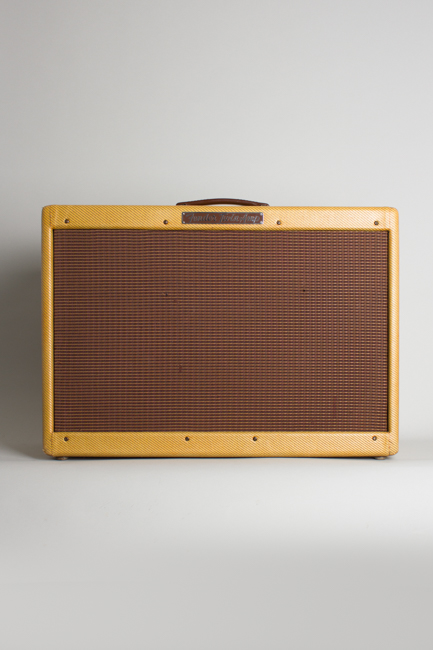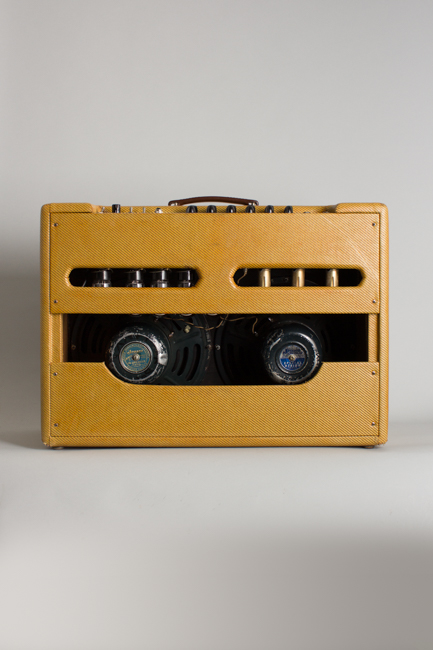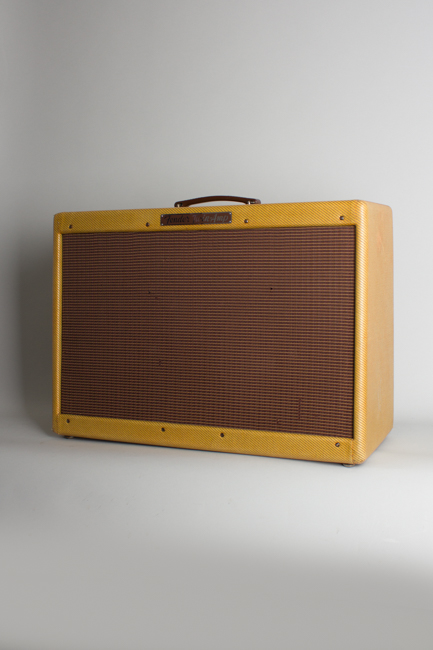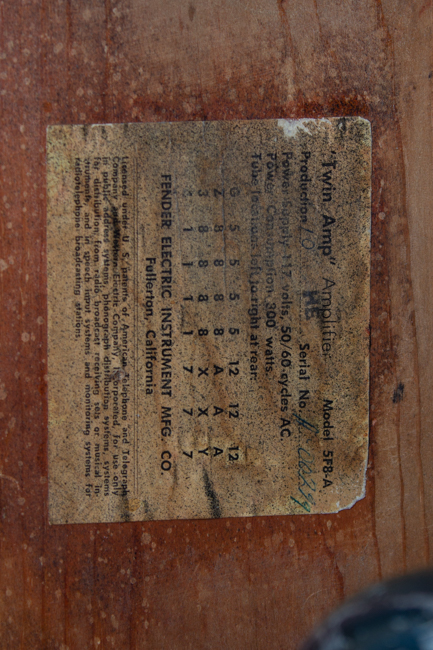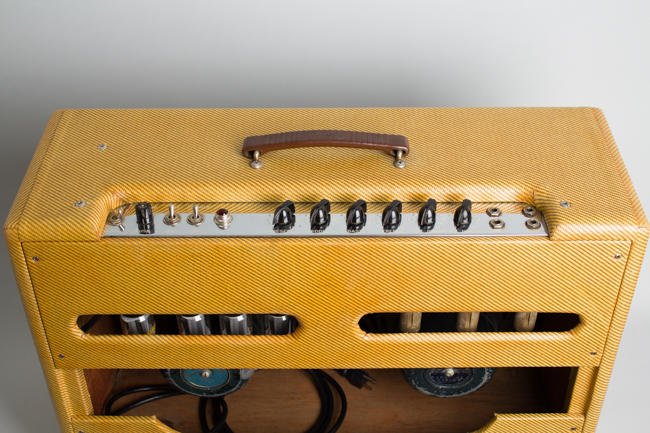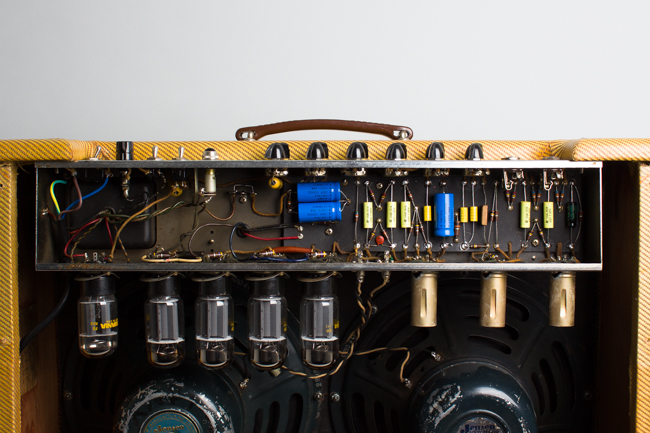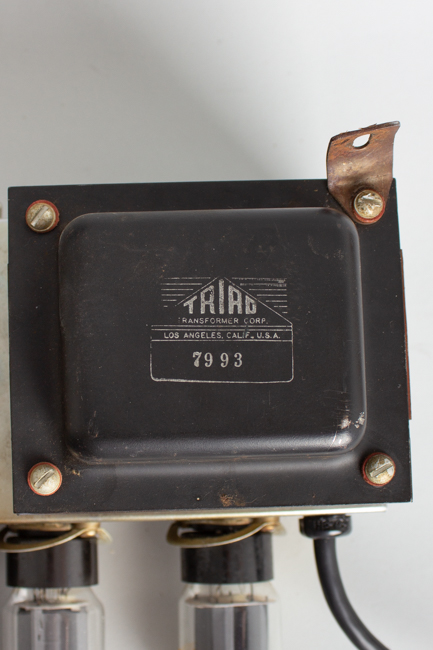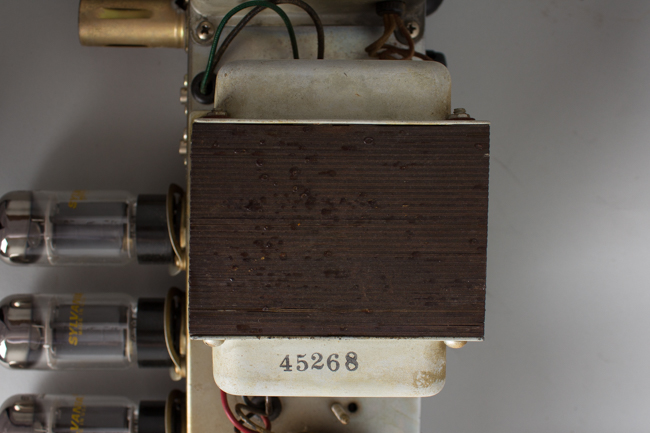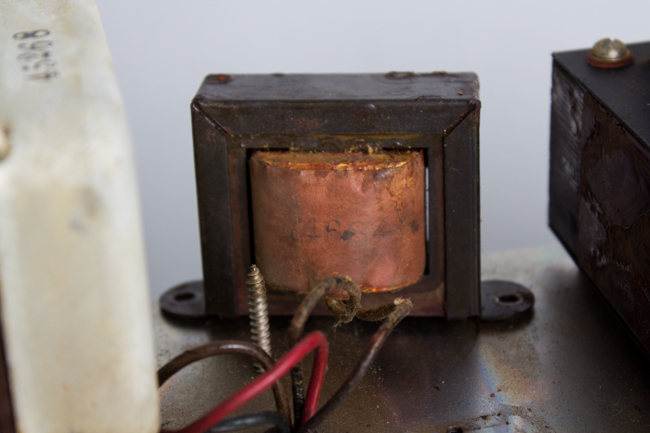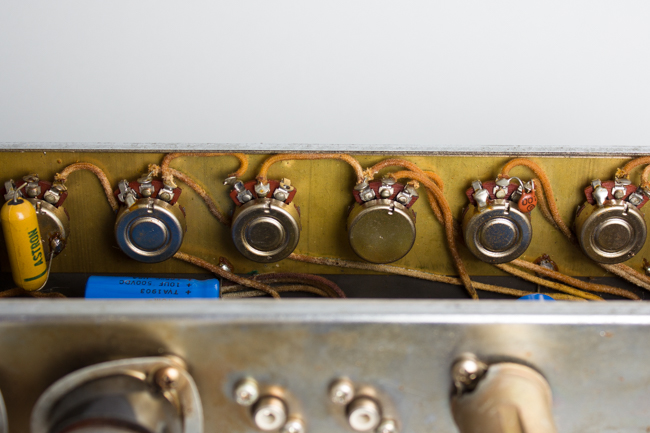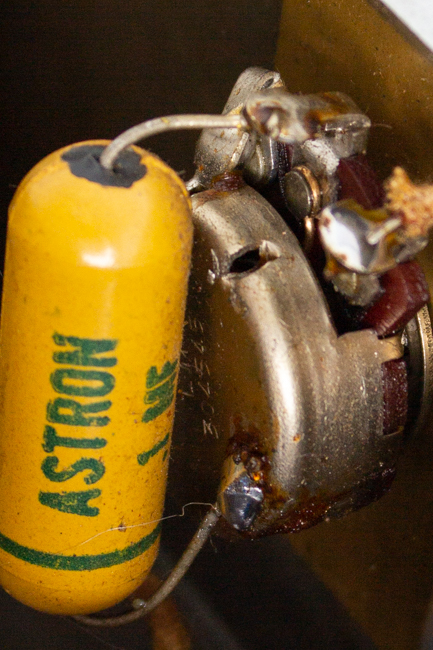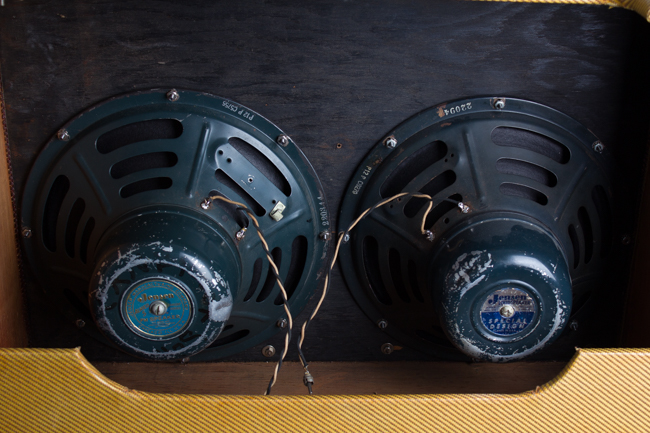Fender Twin Amp 5F8-A High Power Tube Amplifier (1958)
This item has been sold.
Item # 10640
Prices subject to change without notice.
Fender Twin Amp 5F8-A High Power Model Tube Amplifier (1958), made in Fullerton, California, tweed fabric covering finish.
The Fender Twin-Amp was initially unveiled at the summer 1952 NAMM show as Fender's top-line professional amplifier. It remained the flagship model of tweed era Fender amps until 1960, when the new decade brought a revamp of the entire line. The circuit went through many revisions throughout the 1950s, until 1958 when Leo introduced the 85 watt 5F8-A circuit. The 5F8-A revision has since become known as the "High Power Tweed Twin" and is regarded as one of Leo's finest achievements. This is simply the most desired standard production Fender amp ever made, and arguably one of the most collectible amplifiers of all time.
In 1956 the 5E8 was initially made with twin 5U4 rectifier tubes in order to give it more headroom and tighter attack, as well a dual 5881 power section. This puts out around 50 watts into two Jensen P12N speakers arranged diagonally in a smaller cabinet. The following year came the somewhat short-lived 5F8, featuring a single 5U4 rectifier, quad 5881 power tubes and a larger output transformer putting out around 80 watts, an astounding amount of power for the time.
The F revision also featured a "Middle" control in the tone stack and a different input jack arrangement, now allowing for channel "jumpering", as later famously used on Marshalls in order to saturate the preamp. The final -A iteration went back to a horizontal speaker arrangement in a bigger box as well as further boosting the power output. The 5F8-A Twin is essentially a 5F6-A Bassman with double the power tubes and two 12" speakers instead of four 10's, it retains that amp's toneful glory with more headroom on the output side. Many of the world's most well regarded players have long considered this exact Twin iteration the amp of choice for higher volume situations.
Height is 18 1/2 in. (47 cm.), 26 1/2 in. (67.3 cm.) width, and 10 1/2 in. (26.7 cm.) deep.
This Twin is an overall well preserved but partially restored specimen of this Fullerton-made holy grail. The tube chart bears the stamp HE, indicating assembly in May, 1958. The cabinet has been professionally recovered to a high standard and has a nice amber patina reminiscent of the look of a mint condition original tweed found today. The faceplate is in impeccable shape overall; the chrome-plated finish is mirror clean and virtually all the stenciled lettering is intact, save for a few very minor missing bits on the "bright" and "ground" lettering. The baffle and old-style tri-color Oxblood grille cloth appear to be original. The cloth is taut and has a few very minor signs of tearing/fraying. The handle is an old vintage piece and likely original to the amp, it is possible this is an old replacement.
Electrically the amp is nicely original save for the speakers, both of which are era-correct replacement Jensen P12P models (same as the N magnets used but with a smaller voice coil diameter). One is date coded to the 4*th week (last digit is not legible) of 1959 and the other to the 44th week of 1953. Both have been reconed professionally and sound phenomenal. The power, choke and output transformers are all the original Triads marked 7993, 45268 and 4684, respectively. This Twin was originally lovingly wired up by Lily and bears her signature on a piece of masking tape inside the chassis.
The amp has seen our usual maintenance and servicing, including replacement of all electrolytic caps, a grounded 3-prong power cord, cleaning of all sockets, pots and jacks and biasing to spec. The amp comes with a black leather cover. While not 100% original this remains a super attractive and simply superb sounding unit, and (dare we say it) its recovered state means it could be gigged or employed in a studio without fear that the smallest ding to the tweed would cause devaluation trauma. Beautiful to behold and sonically glorious, this imposing amp is a testament to Leo Fender's genius, the finest in the world when new and to some players never equaled to this day. Restored to Excellent Condition.
The Fender Twin-Amp was initially unveiled at the summer 1952 NAMM show as Fender's top-line professional amplifier. It remained the flagship model of tweed era Fender amps until 1960, when the new decade brought a revamp of the entire line. The circuit went through many revisions throughout the 1950s, until 1958 when Leo introduced the 85 watt 5F8-A circuit. The 5F8-A revision has since become known as the "High Power Tweed Twin" and is regarded as one of Leo's finest achievements. This is simply the most desired standard production Fender amp ever made, and arguably one of the most collectible amplifiers of all time.
In 1956 the 5E8 was initially made with twin 5U4 rectifier tubes in order to give it more headroom and tighter attack, as well a dual 5881 power section. This puts out around 50 watts into two Jensen P12N speakers arranged diagonally in a smaller cabinet. The following year came the somewhat short-lived 5F8, featuring a single 5U4 rectifier, quad 5881 power tubes and a larger output transformer putting out around 80 watts, an astounding amount of power for the time.
The F revision also featured a "Middle" control in the tone stack and a different input jack arrangement, now allowing for channel "jumpering", as later famously used on Marshalls in order to saturate the preamp. The final -A iteration went back to a horizontal speaker arrangement in a bigger box as well as further boosting the power output. The 5F8-A Twin is essentially a 5F6-A Bassman with double the power tubes and two 12" speakers instead of four 10's, it retains that amp's toneful glory with more headroom on the output side. Many of the world's most well regarded players have long considered this exact Twin iteration the amp of choice for higher volume situations.
Height is 18 1/2 in. (47 cm.), 26 1/2 in. (67.3 cm.) width, and 10 1/2 in. (26.7 cm.) deep.
This Twin is an overall well preserved but partially restored specimen of this Fullerton-made holy grail. The tube chart bears the stamp HE, indicating assembly in May, 1958. The cabinet has been professionally recovered to a high standard and has a nice amber patina reminiscent of the look of a mint condition original tweed found today. The faceplate is in impeccable shape overall; the chrome-plated finish is mirror clean and virtually all the stenciled lettering is intact, save for a few very minor missing bits on the "bright" and "ground" lettering. The baffle and old-style tri-color Oxblood grille cloth appear to be original. The cloth is taut and has a few very minor signs of tearing/fraying. The handle is an old vintage piece and likely original to the amp, it is possible this is an old replacement.
Electrically the amp is nicely original save for the speakers, both of which are era-correct replacement Jensen P12P models (same as the N magnets used but with a smaller voice coil diameter). One is date coded to the 4*th week (last digit is not legible) of 1959 and the other to the 44th week of 1953. Both have been reconed professionally and sound phenomenal. The power, choke and output transformers are all the original Triads marked 7993, 45268 and 4684, respectively. This Twin was originally lovingly wired up by Lily and bears her signature on a piece of masking tape inside the chassis.
The amp has seen our usual maintenance and servicing, including replacement of all electrolytic caps, a grounded 3-prong power cord, cleaning of all sockets, pots and jacks and biasing to spec. The amp comes with a black leather cover. While not 100% original this remains a super attractive and simply superb sounding unit, and (dare we say it) its recovered state means it could be gigged or employed in a studio without fear that the smallest ding to the tweed would cause devaluation trauma. Beautiful to behold and sonically glorious, this imposing amp is a testament to Leo Fender's genius, the finest in the world when new and to some players never equaled to this day. Restored to Excellent Condition.
